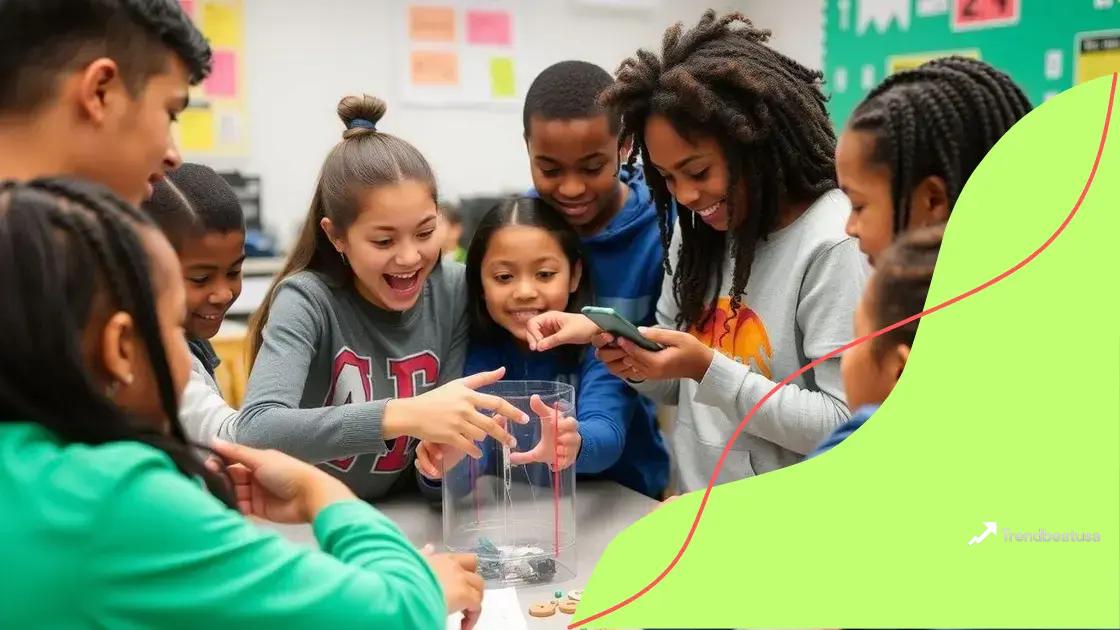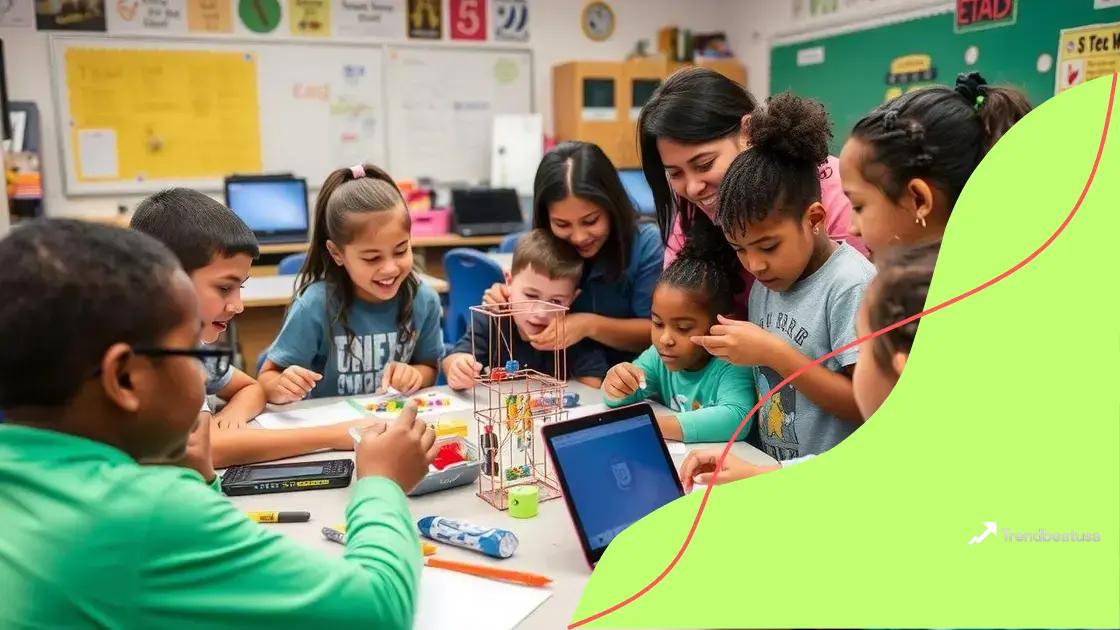STEM education receives additional support from new initiatives

STEM education focuses on hands-on learning, interdisciplinary approaches, and technology integration to prepare students for future careers in a rapidly evolving, tech-driven world.
STEM education receives additional support as schools and communities recognize its critical role in student development. Have you noticed how these programs can reshape educational landscapes? Let’s explore what’s happening.
Understanding the importance of STEM education
Understanding the importance of STEM education is essential as it lays the foundation for many skills needed in the future. Many students struggle with traditional learning methods, making STEM initiatives crucial to enhance their learning experience.
In today’s world, where technology and science are rapidly evolving, STEM education fosters critical thinking, creativity, and problem-solving abilities. These skills are vital in nearly every career path, as they prepare students for real-world challenges.
Key Aspects of STEM Education
STEM encompasses various fields, including science, technology, engineering, and mathematics. Each component plays a significant role in holistic education:
- Science: Encourages inquiry and experimental learning.
- Technology: Involves understanding and using tools effectively.
- Engineering: Promotes innovation through design and building.
- Mathematics: Develops analytical skills essential for problem-solving.
When integrating these subjects, students find interconnections that make learning more relevant and engaging. This method not only enhances knowledge but also generates enthusiasm.
Hands-on projects, such as building robots or conducting experiments, motivate students to explore and relate academic concepts to real-life situations. By applying what they learn, students can see the tangible outcomes of their efforts.
Benefits of STEM Education
The advantages of a strong foundation in STEM are numerous. Students exposed to STEM experiences:
- Gain practical skills that are valuable in the job market.
- Become more resilient and adaptable in unpredictable environments.
- Enhance their team collaboration skills through group projects.
The collaborative nature of STEM education prepares students not only for academic success but also for effective teamwork essential in modern workplaces.
Overall, recognizing the importance of STEM education helps society cultivate a generation equipped with the skills necessary to thrive in diverse fields. Investing in STEM initiatives today enables future advancements that can solve pressing global challenges.
Recent initiatives supporting STEM programs
Recent initiatives supporting STEM programs have been emerging across the globe to encourage a passion for science and technology among students. These initiatives aim to create more engaging learning environments and ensure that students are well-prepared for future careers.
One significant initiative is the integration of project-based learning in classrooms. Through hands-on projects, students can apply what they learn in real-world situations, enhancing their understanding of STEM concepts. For example, schools are hosting robotics competitions that motivate students to work together and think critically.
Government and Private Sector Involvement
Both government and private organizations are investing in STEM initiatives. Funding is being allocated to enhance resources and teacher training. This includes:
- Grants for schools: Financial support to develop STEM curricula and programs.
- Partnerships with businesses: Collaborations provide students with internship opportunities to gain practical experience.
- Workshops and seminars: Offering educators professional development to improve teaching methods in STEM areas.
Such collaborations between schools and industry leaders foster an atmosphere where students can explore future careers while still in school.
Additionally, many nonprofit organizations focus on increasing diversity in STEM fields. They create programs tailored to underrepresented groups, ensuring that all students have access to quality education and resources. These programs often include mentorship opportunities, where professionals guide students through hands-on experiences and learning.
The Impact of Technology in Education
With the rise of technology, many initiatives use digital tools to enhance learning. Online platforms provide resources and lessons that can be accessed at any time. This flexibility allows students to learn at their own pace and explore topics that interest them most.
In summary, recent initiatives supporting STEM programs are essential for fostering a skilled workforce capable of addressing contemporary challenges. By creating engaging, hands-on learning opportunities, students can develop the knowledge and skills necessary to succeed in a technology-driven world. Investing in these initiatives will benefit not only individuals but society as a whole.
How schools are implementing STEM curricula

How schools are implementing STEM curricula is a key area of focus as educators aim to enhance students’ interest and skills in these important fields. Schools are adopting various strategies to create engaging and effective STEM learning environments.
One effective method is through integrated lesson plans. These lesson plans combine subjects, allowing students to see the connections between science, technology, engineering, and mathematics. For example, a project that requires students to design a simple machine can involve principles from physics and math, giving them a real-world application.
Emphasizing Hands-On Learning
Many schools are prioritizing hands-on learning experiences. Such experiences encourage students to think critically and work collaboratively:
- Robotics clubs: Students build and program robots which promotes teamwork and problem-solving skills.
- Science fairs: These events allow students to showcase their experiments, fostering creativity and innovation.
- Field trips: Visiting science centers or engineering firms gives students a firsthand look at STEM careers.
These activities not only enhance practical skills but also keep students more engaged with their studies. Additionally, schools are using technology to facilitate learning. Digital tools, like simulations and interactive software, help reinforce complex concepts.
Teacher Training and Resources
Another important aspect of implementing STEM curricula is teacher training. Schools are investing in professional development to equip teachers with the skills they need to effectively teach STEM subjects. Workshops and seminars are common, allowing educators to learn new strategies that improve their teaching methods.
Furthermore, schools are accessing various resources to support their STEM programs. This includes online platforms that provide lesson plans, activities, and instructional materials. By utilizing these resources, teachers can create more dynamic and effective lessons.
In conclusion, schools are embracing STEM education through integrated lessons, hands-on experiences, and dedicated teacher training. By implementing these strategies, they are preparing students for future challenges in a technology-driven world. The focus on STEM not only enhances academic skills but also ignites a passion for learning that extends beyond the classroom.
Benefits of hands-on learning in STEM
Benefits of hands-on learning in STEM cannot be overstated. Engaging students in practical activities enhances their understanding of complex concepts. By immersing themselves in a real-world context, students become active participants in their learning journey.
One major advantage of hands-on learning is that it boosts retention rates. When students physically manipulate materials or conduct experiments, they are more likely to remember what they learned. This active involvement helps solidify knowledge and makes learning more enjoyable.
Encouraging Critical Thinking and Problem Solving
Hands-on learning encourages students to think critically and come up with solutions. Working on projects often requires creativity and collaboration. For instance:
- Design challenges: Students design and build projects that reflect their understanding of scientific principles.
- Group activities: Collaborative projects help students learn to communicate and work together effectively.
- Real-life applications: Students see how STEM concepts apply to everyday life, enhancing their relevance.
This approach not only builds confidence but also prepares students for future careers that demand these skills.
Fostering Engagement and Motivation
When students participate in hands-on activities, they tend to be more engaged and motivated. The excitement of building robots, conducting experiments, or solving engineering problems keeps their interest alive. Additionally, this interactive environment encourages students to explore and ask questions, fostering a natural curiosity.
The social aspect of hands-on learning also enhances motivation. Students working in teams learn valuable interpersonal skills, which are essential in any career. As they collaborate with peers, they gain insights from one another, which enriches their understanding.
In conclusion, the benefits of hands-on learning in STEM education include improved retention, critical thinking, and increased student motivation. By involving students in practical experiences, educators create a dynamic learning environment that prepares them for the challenges of the future. This active approach to learning also cultivates a deep appreciation for science and technology.
Future trends in STEM education
Future trends in STEM education are shaping the way we prepare students for the challenges of tomorrow. As technology evolves, so does the approach to teaching science, technology, engineering, and mathematics. Understanding these trends helps educators create effective learning environments.
One major trend is the integration of artificial intelligence in the classroom. AI can provide personalized learning experiences, adapting to each student’s needs and pace. This technology allows for more efficient teaching and can help identify areas where students struggle, guiding them towards improvement.
Emphasis on Interdisciplinary Learning
Another significant trend is the move toward interdisciplinary learning. Schools are blending subjects, allowing students to see the connections between different areas of study. This approach encourages critical thinking and enhances problem-solving skills.
- STEAM education: Incorporating the arts allows for creative expression in scientific fields.
- Project-based learning: Students work on real-world problems, applying knowledge from multiple disciplines.
- Collaboration with industries: Partnerships with businesses provide insights into how STEM applies in the workplace.
By promoting interdisciplinary learning, students can better understand the relevance of their education and how it relates to future careers.
Focus on Coding and Computational Thinking
The emphasis on coding and computational thinking is also growing in STEM education. Schools are recognizing the importance of teaching programming languages to prepare students for tech-driven jobs. Understanding how to code is becoming as essential as traditional literacy.
In addition, educators are incorporating computational thinking into various subjects. This approach teaches students to break down complex problems into manageable parts, fostering analytical skills.
Furthermore, online learning platforms are making STEM education more accessible. Students can learn at their own pace, explore topics of interest, and collaborate with peers from around the world. This flexibility enhances learning and encourages self-directed study.
Overall, keeping an eye on future trends in STEM education helps create a vibrant and engaging learning environment. By embracing technology, interdisciplinary approaches, and coding, educators can better prepare students for a rapidly evolving world.
FAQ – Frequently Asked Questions about STEM Education
What is the importance of hands-on learning in STEM education?
Hands-on learning enhances student engagement and retention of knowledge by allowing them to apply concepts in real-world scenarios.
How does interdisciplinary learning benefit students?
Interdisciplinary learning helps students see connections between different subjects, promoting critical thinking and problem-solving skills.
Why is technology integration important in STEM education?
Integrating technology, such as AI, personalizes learning experiences and helps identify areas where students need support.
What are the future trends in STEM education?
Future trends include greater emphasis on coding, the use of online platforms for learning, and collaboration with industries to prepare students for tech-driven careers.
